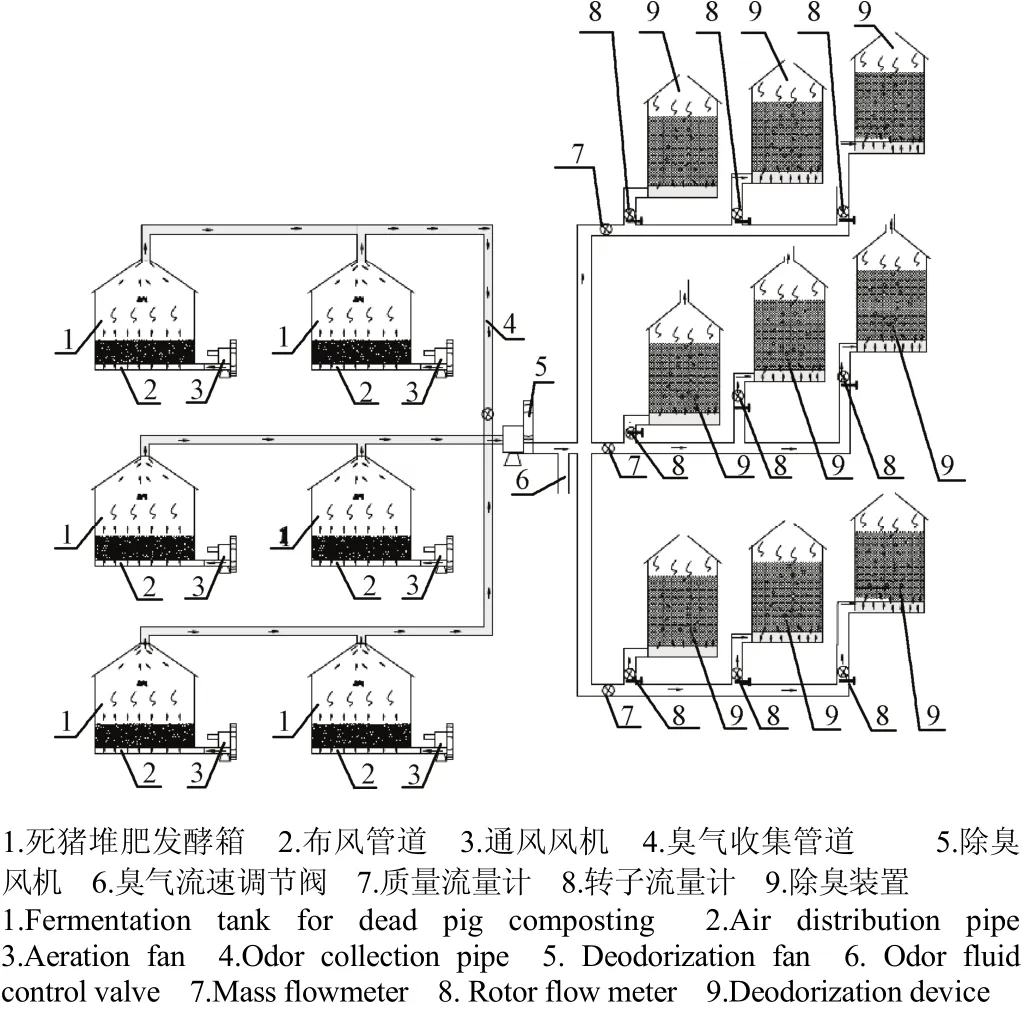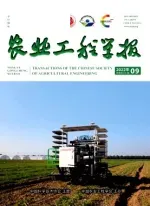生物过滤法去除死猪堆肥排放臭气效果的中试
2017-07-12周谈龙董红敏陶秀萍李路路
尚 斌,周谈龙,董红敏,陶秀萍,李路路,刘 杨
(中国农业科学院农业环境与可持续发展研究所,农业部设施农业节能与废弃物处理重点实验室,北京 100081)
生物过滤法去除死猪堆肥排放臭气效果的中试
尚 斌,周谈龙,董红敏※,陶秀萍,李路路,刘 杨
(中国农业科学院农业环境与可持续发展研究所,农业部设施农业节能与废弃物处理重点实验室,北京 100081)
为研究生物过滤法去除死猪堆肥发酵处理过程产生臭气以及挥发性有机物(volatile organic compounds,VOCs)的可行性,开展了死猪和猪粪混合堆肥试验,分析了死猪堆肥过程臭气浓度特性和VOCs组分特征,对生物过滤法去除臭气中VOCs的工艺关键参数-停留时间进行优化试验。死猪堆肥过程中排放VOCs种类达37种,其中主要致臭组分为三甲胺、二甲基硫、二甲基二硫、二甲基三硫;以腐熟猪粪堆肥作为滤料(添加3%活性污泥),在停留时间为30~100 s的条件下,生物过滤法对死猪堆肥排放臭气去除率达90%以上;停留时间60~100 s的条件下对VOCs中主要致臭组分的去除效率达82.2%~100%,生物过滤法去除死猪堆肥过程臭气浓度和VOCs的优化停留时间为60 s。研究结果能为死猪堆肥发酵过程排放臭气的处理和控制技术进一步研发提供科学依据。
堆肥;恶臭;生物过滤法;挥发性有机物;除臭;死猪
0 引 言
堆肥作为畜禽粪便处理最为常用的方法之一[1-2],目前已经被许多发达国家用于动物尸体的处理上[1-4]。死猪堆肥发酵处理法运行成本低、处理效果好,尤其在畜禽疫病爆发时,利用堆肥法能够在场内将病死畜禽就地进行无害化处理,将疫病病菌完全控制在场内,从而避免了由于运输而导致疫病传播的可能性[5-6]。因此,国内外对死畜禽尸体堆肥处理技术均开展了相应的研究[6-10]。
死猪堆肥处理是将猪粪和死猪混合堆肥,在利用堆肥发酵产生的高温将病原菌杀死的同时,将死猪尸体降解。与普通堆肥一样,死猪堆肥同样面临臭气污染的问题。在堆肥排放气体中,除氨和硫化氢是恶臭的主要来源外,还有少量挥发性有机物(volatile organic compounds,VOCs)[11],VOCs虽然含量不高,但其对环境危害不可忽视,一方面VOCs对人类和动物的呼吸系统、内分泌系统、循环系统及神经系统产生刺激,危害身体健康;另一方面,VOCs中的含氮有机物、含硫有机物及挥发性脂肪酸是典型臭气物质[12],其是堆肥排放臭气的重要组成部分。因此,研究死猪堆肥处理过程VOCs和臭气浓度控制技术对死猪堆肥技术的推广应用具有重要意义。
关于堆肥过程臭气和VOCs的产生及控制技术目前国内外已有一定的研究[13-16]。大部分学者均采用生物过滤法对臭气和VOCs进行去除[17-18]。生物过滤法属于生物除臭法的一种,一般适用于堆肥过程的臭气去除,其对氨气的去除率很高,通常在95% 以上,是一种较为经济有效的去除臭气的方法[19-20]。影响生物过滤法除臭效果的因素主要包括滤料特性(种类、含水率等)以及停留时间等。生物过滤法可选用的滤料较多,无机或有机材料都可以作为滤料用以除臭,其中腐熟堆肥经过筛分处理后作为生物滤料进行臭气去除效果好且成本低,应用最为广泛[18,21]。陆日明等研究了不同填料去除鸡粪堆肥臭气效果,其认为,在优化工艺参数滤料高度50 cm、填料初始含水率为50%以及停留时间为90.0 s时处理效果最佳,对堆肥臭气中VOCs有很好的去除效果,处理率高达98.30%[18];袁京等以腐熟堆肥为滤料进行了堆肥气中氨气的去除试验,其认为在一定的滤池高度下,可将氨气100%去除[17];Park等利用腐熟堆肥和粉碎后椰子皮1∶1混合后作为吸收材料进行堆肥除臭试验,结果发现腐熟堆肥和粉碎后椰子皮能将猪粪堆肥氨气几乎全部去除[22];Pagans等也以腐熟堆肥作为滤料进行除臭试验,其认为腐熟堆肥可用于多种废弃物堆肥臭气的去除,对氨气的去除率能够达到95%以上[12]。
目前,关于堆肥除臭的研究多集中在普通堆肥方面,并无针对死猪堆肥排放臭气浓度和VOCs去除方面的研究。本研究以腐熟堆肥作为滤料,采用生物过滤法对死猪堆肥处理过程产生的臭气浓度和VOCs进行去除,同时针对生物除臭的关键参数停留时间开展优化试验,为生物过滤法去除死猪堆肥臭气和VOCs的实际应用提供科学依据。
1 材料与方法
1.1 试验装置及材料
除臭系统示意图如图1所示,死猪堆肥过程排出的气体通过管道连接到除臭风机进风口。除臭风机出风口与除臭装置的底部进气口相连。除臭试验采用底部进气和顶部出气的方式进行,每个除臭装置的进气流速均采用流量计进行控制。

图1 除臭系统示意图Fig.1 Schematic diagram of deodorization system
堆肥发酵箱体的外部尺寸为1 m×1 m×1 m(长×宽×高);材料为硬质PVC板,箱体外层加5 cm厚聚苯保温层。发酵箱底部设有送风管道,管道设有通风小孔,小孔直径约为3 mm,通风管道上设置一硬质塑胶筛板,筛板上有直径为5 mm左右的小孔,用以将气体均匀布置,同时避免物料堵塞通气管。堆肥发酵所用通风风机为漩涡风机(2PB710-H37,苏州风力士),正压送风,通风率采用热式质量流量计(RK100,北京科力博奥仪表技术有限公司)和玻璃转子流量计(LZB-60,上海天湖仪表厂)进行精确控制和计量。
除臭装置尺寸为圆形桶(内径0.3 m),材质为PVC,除臭材料净高100 cm,体积为0.07 m3。臭气进气口在圆形桶底部,通过底部布风管进行布气,经除臭材料处理后排出,顶部设置气体采样口和臭气排放口。所用除臭风机为漩涡风机(2PB610-H16,苏州风力士),臭气流速采用热式质量流量计(RK100,北京科力博奥仪表技术有限公司)和玻璃转子流量计进行精确控制和计量。
除臭材料为已经发酵腐熟的猪粪和秸秆混合堆肥,添加3%左右的活性污泥,基本特性见表1。

表1 除臭材料初始特性Table 1 Characteristics of biofilter packing materials
1.2 试验设计
死猪堆肥发酵原料为猪粪和玉米秸秆,猪粪来自北京安定种猪场,玉米秸秆取自北京市大兴区安定镇西白塔村,经粉碎机切割至5 cm左右的小段。玉米秸秆和猪粪按体积比2∶1混合,所用猪粪和玉米秸秆以及混合后的堆料特性如表2。

表2 死猪堆肥处理所用原料特性Table 2 Characteristics of composting materials for dead pigs treatment
死猪堆肥发酵处理的做法为:先在堆肥箱内放入厚度40 cm左右搅拌均匀的物料,然后将死猪放入,所有死猪未经任何前处理,整体放入堆肥箱体内,在死猪尸体上覆盖堆肥物料至箱体放满。试验设计在发酵4周后翻堆1次,其他时间根据发酵箱体内物料的温度变化情况决定是否需要翻堆,如果箱体内堆肥温度下降比较明显,则进行翻堆,否则不翻堆;翻堆时根据含水率情况判断是否需要补充水分,如果翻堆时物料明显偏干,则补充水分至50%~60%,到达手握成团,松手既散的状态即可。
为保证通入除臭装置的气体为死猪堆肥正常发酵过程中排出的臭气,应尽可能多设置发酵箱体,本试验中死猪堆肥共设6个发酵箱,每个发酵箱容积为1 m3,其处理死猪初始质量分别为35.4、28.1、78.2、35.5、91.0、33.3 kg,堆体死猪处理率平均为55.3 kg/m3。
堆肥通风率统一控制,均设置为60 L/(min·m3)。通风方式为间歇式通风,利用时间继电器自动控制,风机运行10 min后停20 min,如此循环。发酵产生的臭气全部收集并集中到一个管道内,采用流量计分布到不同处理箱进行处理。
停留时间设3个处理(30、60和100 s,表3),每个处理3个重复。

表3 除臭试验设计Table 3 Experiment arrangement and parameters of biofilters
1.3 测试项目和分析方法
臭气浓度采样和测试:臭气主要集中在堆肥前期发生,因为在堆肥前期尽可能多采样。本试验中采集臭气采用比较式臭袋法[23]进行采用测定浓度,程序非常复杂,因此设计第1周采样2次,之后每周采样1~2次。本试验当天及第2、7、15、20、23、29、36和42天分别在堆肥发酵臭气排放口和处理后气体排放口的进行臭气浓度采样和测试。
VOCs采样和测试:试验开始当天及第1~7、10、14、21、28、35和42天在堆肥发酵臭气排放口,以及试验当天及第7、10、14、21、28、35和42天在除臭装置气体排放口分别进行VOCs采样和测试[24]。方法为:利用容积为3.2 L的苏玛罐采集的气体通过冷阱浓缩仪(美国ENTECH7100)去除O2、N2、CO2,富集后进入气相色谱质谱联用仪(7890A/5975C)测试,色谱柱为美国安捷伦DB-624 60 m×0.25 mm×1.8 µm,程序升温为初始温度−10 ℃,保持10 min,然后以3.0 ℃/min升到100 ℃,再以10.0 ℃/min升到220 ℃,保持15 min。进样口温度:140 ℃,溶剂延迟时间:0.5 min,载气流速:1.0 mL/min。离子源温度:250 ℃,扫描方式:选择离子扫描;VOCs成分通过对照标样的保留时间和特征离子进行定性,采用外标法进行定量分析。采用US EPA PAMS和US EPA TO-142种标气(美国SPECIALTY GAS公司),标气中包括烷烃类35种、芳香烃类22种、卤烃类20种、胺类1种、含硫化合物3种、氟利昂类4种。在气体进样量为400 mL条件下,方法的检出限为0.28~7.5 μg/m3;平行分析浓度为5 nmol/mol(ppb)混合标样10次:相对偏差小于15%;对加标量分别为2.5,5,20 nmol/mol的环境样品重复进行6次加标回收率测定,加标回收率为:75.6%~104.2%,82.5%~105.7%,83.6%~105.4%。
死猪堆肥过程温度利用温度自动记录仪(美国 Onset HOBO U23-003)自动记录。
臭气浓度和VOCs的去除率按下式计算

式中η为生物过滤装置对该气体的去除率,%;C1为除臭装置某气体在进气口的浓度,mg/m3;C2为该气体在除臭装置出气口的浓度,mg/m3。
2 结果与分析
2.1 死猪堆肥过程温度变化分析
堆肥温度是物料无害化程度的重要指标。本试验开始日期为10月18日至12月1日,期间室外日平均温度约在5~15 ℃之间。在试验开始约2 d后,除发酵箱2#、4#、5#外,其他箱体内堆肥温度均升高至60 ℃以上,由于2#、4#和5#箱体在温度升至55 ℃以后缓慢下降,因此在10月31日(第12天)和11月7日(第20天)对2#、4#和5#箱进行了翻堆、11月12日(第25天)对3#箱进行翻堆,翻堆时死猪尸体均大部分腐烂,但含水率仍保持在60%左右,因此翻堆时未加水,翻堆后温度仍能够迅速升高至60 ℃以上。11月17日(第30天),对所有堆肥箱进行了1次翻堆,翻堆后温度上升明显(图2),其中1#、3#和5#在翻堆后第2天(第31天)均上升到60 ℃以上,由于3#和5#箱内初始死猪量最大,翻堆时发现剩余部分肌肉未完全降解骨骼较多,温度重新升高说明死猪又重新开始发酵和降解。
虽然各堆肥箱的温度有差别,但从堆肥温度的变化趋势看,在整个死猪堆肥过程中,6个发酵箱体为堆肥温度达到55 ℃的天数分别为12~38 d,满足《粪便无害化卫生标准》(GB7959-87)和《畜禽粪便无害化处理技术规范》(NY/T1168-2006)的无害化卫生要求,说明整体发酵工艺正常运行。

图2 死猪堆肥过程中发酵箱日平均温度Fig.2 Average dairy temperature in pig manure and swine carcass aerobic fermentation
2.2 死猪堆肥处理过程臭气浓度特性分析
臭气浓度是表征恶臭污染对人体嗅觉刺激程度的常用指标,是表征恶臭物质的综合指标。本试验采用3点比较式臭袋法测定了死猪堆肥处理过程排放臭气浓度及3种不同停留时间(30、60和100 s)工艺参数条件下生物过滤法处理后臭气浓度(表4)。臭气浓度最大值出现在第2天,达17 378(无量纲),之后开始降低。但之后每次翻堆时(第20、25和30天),臭气浓度又出现峰值,为1 738(无量纲),之后又开始下降,试验结束时臭气浓度为302(无量纲)。因此,臭气浓度受堆肥温度的影响较为明显,臭气浓度在第1周内最为强烈,第2周和第3周相对较弱,后期臭气浓度再次升高时由于部分箱体的翻堆导致。

表4 不同停留时间对生物过滤法处理死猪堆肥发酵过程排放臭气浓度的影响Table 4 Effects of retention time on odor concentration from composting of swine manure and carcass by biofiltration
2.3 不同停留时间对生物过滤法处理死猪堆肥排放臭气浓度的影响
3个处理后臭气浓度均为30(无量纲),说明在此试验条件下,处理1(停留时间30 s)、处理2(停留时间60 s)和处理3(停留时间100 s)均能有效降低臭气浓度,且各处理间无差异,其对臭气去除率在90%~100%之间。
2.4 死猪堆肥排放气体中VOCs组分特性
大量研究表明,VOCs排放主要集中在好氧堆肥中前期[25-26]。本试验对死猪堆肥第1周排放气体中VOCs组分每天进行取样测定,共检测出VOCs多达37种(表5),其中甲苯、乙笨、萘、苯乙烯、间,对二甲苯、三甲胺、二甲基硫、二甲基二硫、二甲基三硫均出现高于各自嗅阈值的情况,堆肥当天二甲基二硫和二甲基三硫分别高于各自阈值的110 000和620倍,堆肥第2天三甲胺和二甲基硫高出各自嗅阈值的7 900和1 100倍,因此判断三甲胺、二甲基硫、二甲基二硫、二甲基三硫为死猪堆肥处理过程主要致臭VOCs成分。
由于发酵原料的不同,堆肥发酵过程中主要致臭物质也不同,沈玉君等认为甲硫醚、二甲基二硫、二甲基三硫、乙醛和硫化氢是猪粪堆肥产生的主要致臭物质[15];张红玉等通过试验得出生活垃圾堆肥主要致臭物质为硫化氢、甲硫醚、二甲基二硫、二硫化碳、1,3二甲基苯、邻二甲苯[27],餐厨垃圾堆肥主要致臭物质为甲硫醇、硫化氢、1,3二甲基苯、邻二甲苯、二甲基二硫、对二甲苯[28]。本试验没有测定硫化氢,但分析不同组分浓度与其嗅阈值比较可以发现,VOCs中的致臭物质为酮类和硫醇硫醚类。

表5 死猪堆肥开始第1周挥发性有机物浓度变化Table 5 VOCs content variation during first week composting of swine manure and carcassmg·m-3
2.5 不同停留时间对死猪堆肥排放VOCs致臭物质去除效率的影响
死猪堆肥排放臭气中成分比较复杂,根据2.3分析结果,仅分析不同停留时间对三甲胺、二甲基硫、二甲基二硫、二甲基三硫等4种物质的去除效果。死猪堆肥开始阶段,三甲胺质量浓度较高,接近6 mg/m3,经处理后质量浓度降低至0~0.7 mg/m3,堆肥过程中翻堆会导致其浓度再次升高至4 mg/m3左右,试验中处理1(停留时间30 s)、处理2(停留时间60 s)和处理3(停留时间100 s)对三甲胺去除率平均值分别为92.9%、100%和100%;二甲基硫、二甲基二硫、二甲基三硫质量浓度最高值均出现在堆肥当天,分别为2.65、11.0和3.74 mg/m3,之后浓度逐渐降低,浓度出现波动是由于翻堆引起的。
生物过滤法对二甲基硫、二甲基二硫、二甲基三硫均有较好的去除效果(图3),3组处理对二甲基硫去除率平均值分别为79.2%、82.2%和95.4%,对二甲基二硫去除率平均值为81.9%、89.1%和94.0%,对二甲基三硫的去除率分别为76.7%、98.4%和99.1%,通过统计分析认为,处理2和处理3对主要致臭VOCs的去除率显著高于处理1(P<0.05),但处理2和处理3差别不显著(P>0.05)(表6),因此建议选择60 s的停留时间。

图3 不同停留时间对死猪堆肥过程4种主要致臭挥发性有机物去除效果的影响Fig.3 Effects of retention time on biofiltrationodor concentration of VOCs from composting of swine manure and carcass

表6 不同处理条件下主要致臭VOCs的去除率Table 6 Removal efficiency of main odorant of VOCs %
试验气体采样时,尽量保证进气和处理后气体同时采集,但实际操作过程中,难免会造成时间偏差,而堆肥二甲二硫受通风率、C/N和含水率的影响[29-30],不同时间采样可能会出现一定的波动。试验第10天出现的处理1经生物过滤后二甲基二硫质量浓度(0.93 mg/m3)高于进气二甲基二硫质量浓度(0.38 mg/m3)的情况,应该是由于采样时间差造成的。
3 结 论
1)死猪和猪粪堆肥过程共检测出37种VOCs,其中芳香烃12种、卤代烃21种、酮类1种、硫醇硫醚类3种;VOCs中主要致臭物质为三甲胺、二甲基硫、二甲基二硫、二甲基三硫。
2)以腐熟堆肥作为滤料,在停留时间30~100 s的条件下,生物过滤法对死猪堆肥排放臭气浓度去除率达90%以上;停留时间60~100 s的条件下,生物过滤法对VOCs中主要致臭组分处理率为82.2%~100%;建议优化停留时间为60 s。
[1] 李季,彭生平. 堆肥工程实用手册[M]. 第2版. 化学工业出版社,2011.
[2] 曹云,常志州,黄红英,等. 畜禽粪便堆肥前期理化及微生物性状研究[J]. 农业环境科学学报,2015,34(11):2198-2207. Cao Yun, Chang Zhizhou, Cao Hongying, et al. Chemical and biological changes during early stage of composting of different animal wastes[J]. Journal of Agro-Environment Science, 2015, 34(11): 2198-2207. (in Chinese with English abstract)
[3] AhnHeekkwon, Richard Tom L, Glanville Thomas D. Optimum moisture levels for biodegradation of mortality composting envelope materials [J]. Waste Management, 2008, 28(8): 1411-1416.
[4] Ahn Heekwon, Glanville Thomas D, Crawford Benjamin P, et al. Evaluation of the Biodegradability of Animal Carcasses in Passively Aerated Bio-secure Composting System[M]// Agricultural and Biosystems Engineering Conference Papers, Posters and Presentations, 2007.
[5] Neslihan A, Koziel J A, Hee-Kwon A, et al. Field scale evaluation of volatile organic compound production inside biosecure swine mortality composts[J]. Waste Management, 2010, 30(10): 1981-1988.
[6] Glanville T D, Ahn H, Akdeniz N, et al. Performance of a plastic-wrapped composting system for biosecure emergency disposal of disease-related swine mortalities[J]. Waste Management, 2015. http://dx.doi.org/10.1016/j.wasman.2015.11.006.
[7] 习佳林. 通风对堆肥处理死鸡效果的影响[D]. 北京:中国农业科学院,2010. Xi Jialin. Influence of Ventilation on the Dead Chickens Decomposition in Compost[D]. Beijing: Chinese Academy of Agricultural Sciences, 2010. (in Chinese with English abstract)
[8] 郭东坡,陶秀萍,尚斌,等. 死猪堆肥处理的通风率选择探讨[J]. 农业工程学报,2013,29(5):187-193. Guo Dongpo, Tao Xiuping, Shang Bin, et al. Selection ofventilation rates on dead pig composting[J].Transactions of the Chinese Society of Agricultural Engineering (Transactions of the CSAE), 2013, 29(5): 187-193. (in Chinese with English abstract)
[9] 董红敏,尚斌,陶秀萍. 猪场粪便与死猪堆肥处理技术与应用[J]. 中国畜牧杂志,2015,51(18):50-53. Dong Hongmin, Shang Bin, Tao Xiuping. Treatment of dead pigs by composting with swine manure and the on-farm application[J]. Chinese Journal of Animal Science, 2015, 51(18): 50-53. (in Chinese with English abstract)
[10] 尚斌,陶秀萍,董红敏,等. 死猪堆肥处理通风率的优化试验[J]. 农业环境科学学报,2014,33(10):2047-2052. Shang Bin, Tao Xiuping, Dong Hongmin, et al. Optimum ventilation rates for pig carcass composting[J]. Journal of Agro-Environment Science, 2014, 33(10): 2047-2052. (in Chinese with English abstract)
[11] Anfruns A, Martin M J, Montes-Morán M A. Removal of odourous VOCs using sludge-based adsorbents[J]. Chemical Engineering Journal, 2011, 166(3): 1022-1031.
[12] Pagans E, Barrena R, Font X, et al. Ammonia emissions from the composting of different organic wastes. Dependency on process temperature[J]. Chemosphere, 2006, 62(9): 1534-1542.
[13] 王玉军,邢志贤,张秀芳,等. 便携式气相色谱-质谱联用仪现场测定畜禽粪便堆肥中挥发性有机物[J]. 分析化学,2012,40(6):899-903. Wang Yujun, Xing Zhixian, Zhang Xiufang, et al. On-site detection of volatile organic compounds during composting treatment of livestock and poultry manure by GC-MS[J]. Chinese Journal of Analytical Chemistry, 2012, 40(6): 899-903. (in Chinese with English abstract)
[14] 沈玉君,高定,陈同斌,等. 堆肥过程中挥发性有机物的产生与释放[J]. 中国给水排水,2011,27(11):101-103. Shen Yujun, Gao Ding, Chen Tongbin, et al. Production and emission of volatile organic compounds during composting[J]. China Water and Wastewater, 2011, 27(11): 101-103. (in Chinese with English abstract)
[15] 沈玉君,张朋月,赵立欣,等. 猪粪好氧发酵过程中挥发性有机物组分分析及致臭因子的确定[J]. 农业工程学报,2016,32(4):205-210. Shen Yujun, Zhang Pengyue, Zhao Lixin, et al. Component analysis of volatile organic compounds and determination of key odor in pig manure aerobic fermentation process[J]. Transactions of the Chinese Society of Agricultural Engineering (Transactions of the CSAE), 2016, 32(4): 205-210. (in Chinese with English abstract)
[16] Turan N G, Akdemir A, Ergun O N. Removal of volatile organic compounds by natural materials during composting of poultry litter[J]. Bioresource Technology, 2009, 100(2): 798-803.
[17] 袁京,杜龙龙,张智烨,等:腐熟堆肥为生物滤料的生物滤池堆肥堆肥气中NH3的去除效果[J]. 农业环境科学学报,2016,35(1):164-171. Yuan Jing, Du Longlong, Zhang Zhiye, et al. Effect of mature compost biofilter on removal efficiency of NH3produced during composting[J]. Journal of Agro-Environment Science, 2016, 35(1): 164-171. (in Chinese with English abstract)
[18] 陆日明,王德汉,项钱彬,等. 生物滤池填料及工艺参数去除鸡粪堆肥臭气效果研究[J]. 农业工程学报,2008,24(1):241-245. Lu Riming, Wang Dehan, Xiang Qianbin, et al. Effects of biofilter media and operating parameters on biofiltration of odor from chicken manure composting[J]. Transactions of the Chinese Society of Agricultural Engineering (Transactions of the CSAE), 2008, 24(1): 241-245. (in Chinese with English abstract)
[19] Hong J H, Park K J. Wood chip biofilter performance of ammonia gas from composting manure[J]. Compost Science and Utilization, 2004, 12(1): 25-30.
[20] Busca G, Pistarino C. Abatement of ammonia and amines from waste gases: A summary[J]. Journal of Loss Prevention in the Process Industries, 2003, 16(2): 157-163.
[21] 刘璐,陈同斌,郑国砥,等. 污泥堆肥厂臭气的产生和处理技术研究进展[J]. 中国给水排水,2010,26(13):120-124. Liu Lu, Chen Tongbin, Zheng Guodi, et al. Odor production and treatment technologies in sewage sludge composting plant[J]. China Water and Wastewater, 2010, 26(13): 120-124. (in Chinese with English abstract)
[22] Park K J, Choi M H, Hong J H. Control of composting odor using biofiltration[J]. Compost Science and Utilization, 2013, 10(4): 356-362.
[23] 空气质量恶臭的测定三点比较式臭袋法:GB/T14675-1993 [S].
[24] Compendium method TO-14A Determination of volatile organic compounds (VOCs) in ambient air using specially prepared canisters with subsequent analysis by gas chromatography: EPA/625/R-96/010b[S].
[25] Turan N G, Akdemir A, Ergun O N. Emission of volatileorganic compounds during composting of poultry litter[J]. Water, Air, and Soil Pollution, 2007, 184(1/2/3/4): 177-182.
[26] Shen Y, Chen T B, Gao D, et al. Online monitoring ofvolatile organic compound production and emission duringsewage sludge composting[J]. Bioresource Technology, 2012, 123(4): 463-470.
[27] 张红玉,李国学,杨青原. 生活垃圾堆肥过程中恶臭物质分析[J]. 农业工程学报,2013,29(9):192-199. Zhang Hongyu, Li Guoxue, Yang Qingyuan. Odor pollutants analyzing during municipal solid waste (MSW) composting[J]. Transactions of the Chinese Society of Agricultural Engineering (Transactions of the CSAE), 2013, 29(9): 192-199. (in Chinese with English abstract)
[28] 张红玉,邹克华,杨金兵,等. 厨余垃圾堆肥过程中恶臭物质分析[J]. 环境科学,2012,33(8):2563-2568. Zhang Hongyu, Zou Kehua, Yang Jinbing, et al. Analysis of odorpollutants in kitchen waste composting[J]. Environment Science, 2012, 33(8): 2563-2568. (in Chinese with English abstract)
[29] 沈玉君,孟海波,张朋月,等. 猪粪堆肥挥发性有机物的产生规律与影响因素[J]. 农业工程学报,2017,33(5):211-216. Shen Yujun, Meng Haibo, Zhang Pengyue, et al. Generation law and influencing factors of volatile organic compounds during pig manure composting[J]. Transactions of the Chinese Society of Agricultural Engineering (Transactions of the CSAE), 2017, 33(5): 211-216. (in Chinese with English abstract)
[30] Delgado-Rodríguez M, Ruiz-Montoya M, Giraldez I, et al. Influence of control parameters in VOCs evolution during MSW trimming residues composting[J]. Journal of Agricultural and Food Chemistry, 2011, 59(24): 13035-13042.
Pilot scale test on removal effect of odor from pig manure and carcass composting by biofiltration
Shang Bin, Zhou Tanlong, Dong Hongmin※, Tao Xiuping, Li Lulu, Liu Yang
(Key Laboratory of Energy Conservation and Waste Management in Agricultural Structures (MOA), Institute of Environment and Sustainable Development in Agriculture, Chinese Academy of Agricultural Sciences, Beijing, 100081, China)
As one of the harmless treatment methods for animal carcasses, the composting has attracted more and more attention. There will be odor and volatile organic compounds (VOCs) emission during the composting of pig manure and the carcass composting. In order to study the feasibility of odor and VOCs removal by biofiltration, the pilot mixed composting experiment of dead pig and pig manure was carried out. The fermentation materials were pig manure and corn stalks, pig manure was taken from one pig farm in Anding Town, Daxing District, Beijing City, and the corn stalks were taken from local farms, which were cut to 5 cm by the crusher. Corn straw and pig manure were mixed at a volume ratio of 2:1; the water content of mixture was 69.4%, and the total carbon and total nitrogen contents of the mixture (dry-basis) were 34.4% and 3.0%, respectively. Blower used for composting ventilation ran intermittently at 10-minute/20-minute (on/off) cycles, and air was supplied to the composting piles at air flow rate of 60 L/(m3·min). The fermentation period was 42 d. The fermented mature compost was used as the biofilter medium and activated sludge as added material. The odor concentrations and VOCs components during dead pig composting were analyzed. The key parameter i.e. the residence time of the filter material in biofiltration was studied. The results showed that, during the 7-week composting period, the daily average temperature was maintained above 55 ℃ for more than 12 days, so all the composting trials could meet the requirement of China national standard, in which more than 50 ℃ temperature lasting 10 days is required for sterilizations. The odor concentration from pig manure and carcass composting was influenced mainly by composting temperature. The odor concentration was the highest in first 7 days of composting, and relatively weak in the second and third week, but the odor concentration reached another peak value after pile-turning. Thirty-seven kinds of VOCs were discharged during the composting, including 12 kinds of aromatic hydrocarbons, 21 kinds of halogenated hydrocarbons, one kind of ketones and 3 kinds of mercaptans thioethers. Among the VOCs, the smelly and odor-causing matters were trimethylamine, dimethyl sulfide, dimethyl disulfide and dimethyl trisulfide. The biofiltration system presented good performance for odor and VOCs removal. With the retention time of 30-100 s between odor and biofilter medium, the removal efficiency of odor concentration could reach more than 90%, and there was no significant difference between different treatments. And with the retention time of 30-100 s between odor and biofilter medium, the removal efficiencies of the main odorant of VOCs, trimethylamine, dimethyl sulfide, dimethyl disulfide and dimethyl trisulfide, were 82.2%-100%. With the retention time of 60-100 s between odor and biofiltration medium, the removal efficiencies of the main odorant had no significant difference, but was significantly higher than that with the retention time of 30 s. The optimum empty bed retention time (EBRT) of biofiltration for the removal of odor and VOCs was 60 s, and the removal efficiencies of the main odorant of VOCs could reach 82.2%. The study provides data support for mitigating odor and VOCs gas emissions during the composting of pig manure and dead pigs.
composting; odors; biofiltration; volatile organic compounds (VOCs); odor removal; dead pigs
10.11975/j.issn.1002-6819.2017.11.029
S216.1
A
1002-6819(2017)-11-0226-07
尚 斌,周谈龙,董红敏,陶秀萍,李路路,刘 杨. 生物过滤法去除死猪堆肥排放臭气效果的中试[J]. 农业工程学报,2017,33(11):226-232.
10.11975/j.issn.1002-6819.2017.11.029 http://www.tcsae.org
Shang Bin, Zhou Tanlong, Dong Hongmin, Tao Xiuping, Li Lulu, Liu Yang. Pilot scale test on removal effect of odor from pig manure and carcass composting by biofiltration[J]. Transactions of the Chinese Society of Agricultural Engineering (Transactions of the CSAE), 2017, 33(11): 226-232. (in Chinese with English abstract) doi:10.11975/j.issn.1002-6819.2017.11.029 http://www.tcsae.org
2016-11-30
2017-05-15
现代农业产业技术体系建设专项基金(CARS36-36-10B);公益性行业(农业)科研专项项目(201303091)。
尚 斌,主要研究方向为畜禽养殖废弃物处理及资源化利用。北京 中国农业科学院农业环境与可持续发展研究所,100081。
Email:shangbin@caas.cn
※通信作者:董红敏,女,河北新乐人,博士,研究员,主要从事畜牧环境工程方面研究。北京 中国农业科学院农业环境与可持续发展研究所,100081。Email:donghongmin@caas.cn
